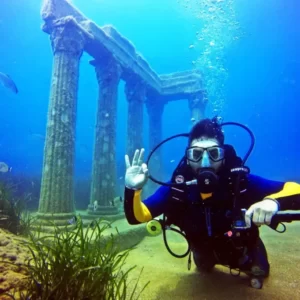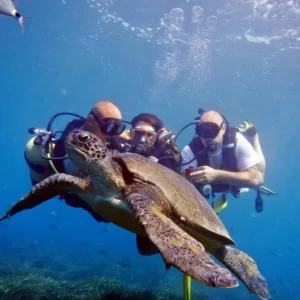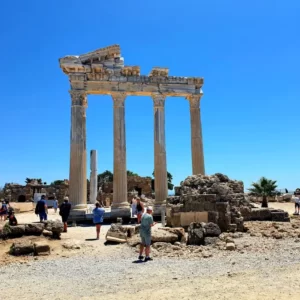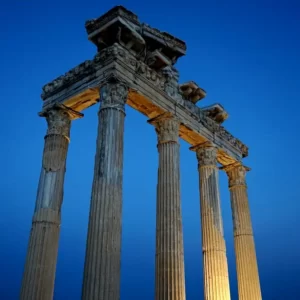About Turkey
About Ancient City of Side
The Ancient City of Side
Throughout Turkey, Antalya is known as the capital of tourism. There are many places to visit and see, especially in Side, the district of Antalya. The Side houses ,4- and 5-star hotels and resorts. Side, which welcomes thousands of tourists every year, also has the opportunity to make holidays for every budget. There are different tourist values in Side, where the heart of tourism beats, such as Manavgat Waterfall, Köprülü Canyon and Trembling Lake.
Where’s Side?
There are certain main points throughout Turkey where tourism is an important source of livelihood. In particular, summer tourism takes place intensively in Antalya and its districts. Side is one of the largest districts of Antalya. Side district, located in the Mediterranean Region, has many tourist facilities and 5-star hotels. Local and foreign tourists who come in the summer also ensure that the population of the district increases in the summer.
How to Get to Side?
It is quite easy to get to Side. Side is located 75 kilometers from Antalya city center. It is possible to choose a road or air route to get to the Side. People who want to go to Side by plane can first buy tickets for flights to Antalya Airport.
There are direct flights to Antalya Airport from many cities throughout Turkey. In addition, a large number of countries from abroad can also be reached by direct flight to Antalya Airport. Some hotels have transfer services from Antalya Airport. In addition, buses and minibusses provide convenient transportation from Antalya to Side. Side can be reached in 20 minutes by minibusses from Antalya Bus Station.
What are the places to visit in Side?
Side is one of the districts that impresses with its touristic and historical values. Home to many civilizations from the past to the present, Side has historical places to visit and see. Side Ancient City BC. It bears traces of the 7th century. There are also some important structures in Side, which hosted empires such as Lydia, Persia, Greek, Roman and Byzantium. The historical agora and agora bath are among the must-see structures. In addition, the Side Antique Theater and the Temple of Apollo stand out with their unique beauties.
Side Antique Theater: It is one of the most beautiful examples of Roman architecture. Side Antique Theater has a capacity of hosting approximately 15 thousand people.
The stage walls of the ancient theater have survived to the present day. This largely preserved structure was used for gladiator and animal fights in the Roman period. It is also architecturally similar to the Colosseum.
Temple of Apollo: The Temple of Apollo is located in the Ancient City of Side. And in the architecture of the temple, there are columns with the Corinthian title. The Temple of Apollo was restored in the 1990s with its admirable majestic architecture.
Manavgat Waterfall: One of Antalya’s best-known natural wonders, Manavgat Waterfall is located in Side. It fascinates the tourists with the view of the waterfall with strong waters pouring from a height of four meters. The waterfall, which is very convenient for rafting, is 15 minutes away from Side town center.
What to do when you go to Side?
There are many activities to do when you go to Side, Antalya. Side Antique City must be visited in order to understand the entire history of the region during a Side holiday. Manavgat Waterfall should also be seen in Side, which is known for its natural beauties.
You should also go to Titreyengöl and Köprülü Canyon. People who love nature sports can do rafting in Manavgat Waterfall.
You can spend a pleasant time relaxing in the cool waters of Köprülü Canyon. In addition, trekking can be done in Titreyengöl. You can also go on a boat tour with the boats departing from Side Marina. Side is one of the most important points to be preferred for summer vacation.
Festivals Held in Side
In Side, which is a tourism paradise, different festivals are held every year at certain times. World Music Culture and Art Festival take place in Side every year in September. In addition, motorcycle enthusiasts can attend the International
Manavgat Motorcycle Festival in the last days of June every year. In addition, the Peace Water Festival takes place in August every year in order to keep Manavgat’s place in tourism alive.
Various aerobatic performances can also take place at the Peace Water Festival. In addition, the Bicycle Festival takes place in October every year for cycling enthusiasts.
Cyclists from Turkey and all over the world cycle in and around Manavgat. The bicycle festival that takes place in Side is also of great interest to everyone.
History of Side
Side, the most important port city of Pamphylia in ancient times, was founded on a peninsula 350-400 m wide, located 80 km east of Antalya, 7 km southwest of Manavgat.
Side, VII BC. was a settlement center in the XIII century. VI BC. in the XIII century, it came under the rule of the Lydian Kingdom along with all of Pamphylia, and after the fall of the Lydian Kingdom in 547/46, it came under the rule of the Persians.
The city, which has preserved its freedom to some extent during this period, has minted coins in its name. The Side, which opened its doors to the king of Macedonia without any resistance during the Anatolian campaign of Alexander the Great (334 BC), later became one of the major coin printing centers established by Alexander.
Side, which constantly changed hands between the kingdoms of the Hellenistic Period after the death of Alexander III DEC. in the XVIII century, was under the rule of the Ptolemies first and the Seleucids in 215-189 BC.
The city was most friendly with Antiochus III, provided the support of the Syrian Kingdom of the kingdoms of Pergamon and Rhodes, took part in the war against the Romans with the Side navy and the Seleucids. At the end of this war, the Seleucids were decumbent and according to the peace of Apameia made in 188 BC, Pamphylia and Side was given to the Kingdom of Pergamon in the meantime.
However, Side regained its independence after a while and experienced one of the brightest periods in history.
The fact that Antiochus VII, who sat on the throne of Syria in 138 BC and later received the nickname “Sidetes”, was sent to Side to study in his youth is an indication of how important the city is important cultural center in the Eastern Mediterranean. This bright period of the city has not lasted long.
1 BC. piracy, which began in the century in the regions of Pisidia and mountainous Cilicia, also jumped to Pamphylia and, consequently, Side, the Sidelians, who could not cope with pirates, had to open their ports and Sundays to them. Finally, after the Roman consul Publius Servilius cleared the region of pirates in 78 BC, Side was annexed to the Roman Empire like the other cities of Pamphylia.
After 25 BC, Augustus made the Pamphylian region a province governed by an officer directly subordinate to him. After this date, Side is a city in the province of Rome. AD II. and III. Side, IV, which has experienced a bright period in the centuries. it has the appearance of a Christian city that was impoverished in the XVIII century. V. and VI. the city experienced its third and last bright time in the centuries and became the capital of the Eastern Pamphylian Metropolitanate. IX. and X. Byzantine emperor Konstantinos Porfirogennetos (913-959) mentions the city, which was thoroughly weakened by Arab raids in the centuries, as a “pirates’ nest’ in his work “De Thematibus”.
The Arab geographer Idrisi calls Side “Yanık Antalya” (towards 1150) and reports that its people were settled in “Yeni Antalya”, which is two days away.
The ruins of the Ancient City of Side, recognized as a commercial and port city, date back to the XX century. the Village of Selimiye was founded by Cretan immigrants at the beginning of the century.
Built on a peninsula, the Side runs along a monumental street starting from the main gate of the city, as in other Pamphylian cities. The main street, which starts from the “Great Gate” in the northeast, runs along the peninsula in the form of an almost straight line, except for the curve in front of the Theater, and ends with a large square near the temples.
The second-largest street of the city also runs from the “Big Gate” to the south of the city. Both streets are colonnaded, with colonnaded porticoes with Corinthian capitals on either side and a row of shops behind them.













